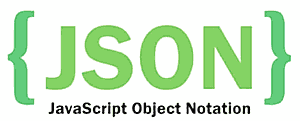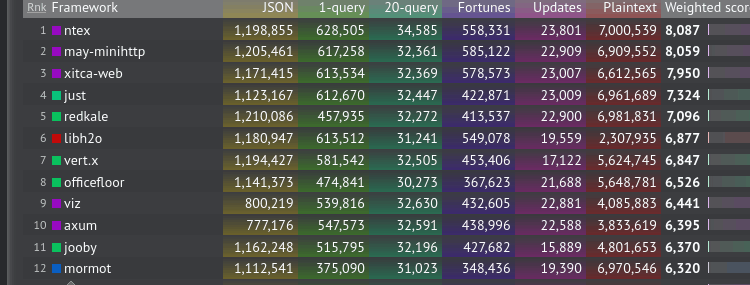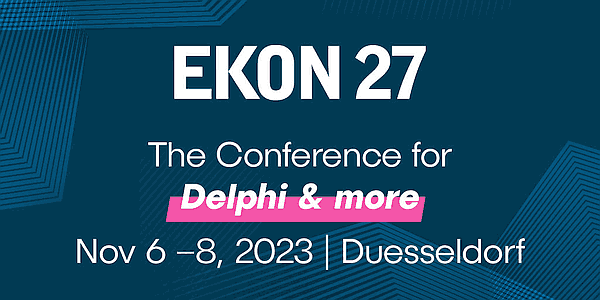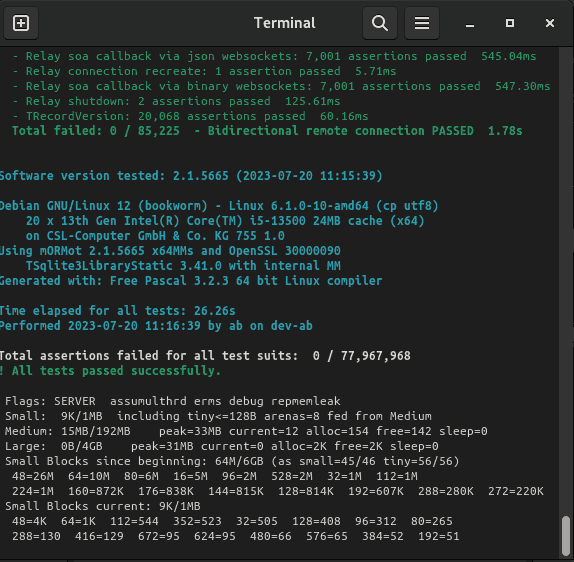TDocVariant Pros and Cons
Since years, our TDocVariant can store any JSON/BSON document-based content, i.e. either:
- Name/value pairs, for object-oriented documents - internally identified as
dvObjectsub-type; - An array of values (including nested documents), for array-oriented documents - internally identified as
dvArraysub-type; - Any combination of the two, by nesting
TDocVariantinstances.
Every TDocVariant instance is also a custom variant type:
- So you can just store or convert it to or from
variantvariables; - You can use late binding to access its object properties, which is some kind of magic in the rigid world of modern pascal;
- The Delphi IDE (and Lazarus 3.x) debuggers have native support of it, so can display its
variantcontent as JSON; - If you define
varianttypes in any class or record, our framework will recognizeTDocVariantcontent and (un)serialize it as JSON, e.g. in its ORM, SOA or Mustache/MVC parts.
Several drawbacks come also from this power:
- Switching between
variantand itsTDocVariantDatarecord may be tricky, and it sometimes requires some confusing pointer references; - Each
TDocVariantinstance could be used as a weak reference to other data, or maintain its own content - in some corner cases, incorrect use may leak memory or get some GPF issues; - A
TDocVariantcould be either an object/dictionary or an array/list, so finding the right methods may be difficult, or raise exceptions at runtime; - It evolved from a simple store to a full in-memory engine, so the advanced features are usually underestimated;
- The
TDocVariantDatarecord is far away from the class system most Delphi/FPC are used to; - By default,
doublevalues are not parsed - onlycurrency- which makes sense if you don't want to loose any precision, but has been found confusing.
Enough complains.
Just make it better.
Entering IDocList and IDocDict Interfaces
We introduced two high-level wrapper interface types:
IDocList(or its aliasIDocArray) to store a list of elements;IDocDict(or its aliasIDocObject) to store a dictionary of key:value pairs.
The interface methods and naming follows the usual Python List and Dictionaries, and wrap their own TDocVariant storage inside safe and class dedicated IDocList and IDocDict types.
You may be able to write on modern Delphi:
var
list: IDocList;
dict: IDocDict;
v: variant;
i: integer;
begin
// creating a new list/array from items
list := DocList([1, 2, 3, 'four', 1.0594631]); // double are allowed by default
// iterating over the list
for v in list do
Listbox1.Items.Add(v); // convert from variant to string
// or a sub-range of the list (with Python-like negative indexes)
for i in list.Range(0, -3) do
Listbox2.Items.Add(IntToStr(i)); // [1, 2] as integer
// search for the existence of some elements
assert(list.Exists(2));
assert(list.Exists('four'));
// a list of objects, from JSON, with an intruder
list := DocList('[{"a":0,"b":20},{"a":1,"b":21},"to be ignored",{"a":2,"b":22}]');
// enumerate all objects/dictionaries, ignoring non-objects elements
for dict in list.Objects do
begin
if dict.Exists('b') then
ListBox2.Items.Add(dict['b']);
if dict.Get('a', i) then
ListBox3.Items.Add(IntToStr(i));
end;
// delete one element
list.Del(1);
assert(list.Json = '[{"a":0,"b":20},"to be ignored",{"a":2,"b":22}]');
// extract one element
if list.PopItem(v, 1) then
assert(v = 'to be ignored');
// convert to a JSON string
Label1.Caption := list.ToString;
// display '[{"a":0,"b":20},{"a":2,"b":22}]'
end;
and even more advanced features, like sorting, searching, and expression filtering:
var
v: variant;
f: TDocDictFields;
list, list2: IDocList;
dict: IDocDict;
begin
list := DocList('[{"a":10,"b":20},{"a":1,"b":21},{"a":11,"b":20}]');
// sort a list/array by the nested objects field(s)
list.SortByKeyValue(['b', 'a']);
assert(list.Json = '[{"a":10,"b":20},{"a":11,"b":20},{"a":1,"b":21}]');
// enumerate a list/array with a conditional expression  for dict in list.Objects('b<21') do
assert(dict.I['b'] < 21);
// another enumeration with a variable as conditional expression
for dict in list.Objects('a=', 10) do
assert(dict.I['a'] = 10);
// create a new IDocList from a conditional expression
list2 := list.Filter('b =', 20);
assert(list2.Json = '[{"a":10,"b":20},{"a":11,"b":20}]');
// direct access to the internal TDocVariantData storage
assert(list.Value^.Count = 3);
assert(list.Value^.Kind = dvArray);
assert(dict.Value^.Kind = dvObject);
// TDocVariantData from a variant intermediary
v := list.AsVariant;
assert(_Safe(v)^.Count = 3);
v := dict.AsVariant;
assert(_Safe(v)^.Count = 2);
// high-level Python-like methods
if list.Len > 0 then
while list.PopItem(v) do
begin
assert(list.Count(v) = 0); // count the number of appearances
assert(not list.Exists(v));
Listbox1.Items.Add(v.a); // late binding
dict := DocDictFrom(v); // transtyping from variant to IDocDict
assert(dict.Exists('a') and dict.Exists('b'));
// enumerate the key:value elements of this dictionary
for f in dict do
begin
Listbox2.Items.Add(f.Key);
Listbox3.Items.Add(f.Value);
end;
end;
// create from any complex "compact" JSON
// (note the key names are not "quoted")
list := DocList('[{ab:1,cd:{ef:"two"}}]');
// we still have the late binding magic working
assert(list[0].ab = 1);
assert(list[0].cd.ef = 'two');
// create a dictionary from key:value pairs supplied from code
dict := DocDict(['one', 1, 'two', 2, 'three', _Arr([5, 6, 7, 'huit'])]);
assert(dict.Len = 3); // one dictionary with 3 elements
assert(dict.Json = '{"one":1,"two":2,"three":[5,6,7,"huit"]}');
// convert to JSON with nice formatting (line feeds and spaces)
Memo1.Caption := dic.ToString(jsonHumanReadable);
// sort by key names
dict.Sort;
assert(dict.Json = '{"one":1,"three":[5,6,7,"huit"],"two":2}');
// note that it will ensure faster O(log(n)) key lookup after Sort:
// (beneficial for performance on objects with a high number of keys)
assert(dict['two'] = 2); // default lookup as variant value
assert(dict.I['two'] = 2); // explicit conversion to integer
end;
for dict in list.Objects('b<21') do
assert(dict.I['b'] < 21);
// another enumeration with a variable as conditional expression
for dict in list.Objects('a=', 10) do
assert(dict.I['a'] = 10);
// create a new IDocList from a conditional expression
list2 := list.Filter('b =', 20);
assert(list2.Json = '[{"a":10,"b":20},{"a":11,"b":20}]');
// direct access to the internal TDocVariantData storage
assert(list.Value^.Count = 3);
assert(list.Value^.Kind = dvArray);
assert(dict.Value^.Kind = dvObject);
// TDocVariantData from a variant intermediary
v := list.AsVariant;
assert(_Safe(v)^.Count = 3);
v := dict.AsVariant;
assert(_Safe(v)^.Count = 2);
// high-level Python-like methods
if list.Len > 0 then
while list.PopItem(v) do
begin
assert(list.Count(v) = 0); // count the number of appearances
assert(not list.Exists(v));
Listbox1.Items.Add(v.a); // late binding
dict := DocDictFrom(v); // transtyping from variant to IDocDict
assert(dict.Exists('a') and dict.Exists('b'));
// enumerate the key:value elements of this dictionary
for f in dict do
begin
Listbox2.Items.Add(f.Key);
Listbox3.Items.Add(f.Value);
end;
end;
// create from any complex "compact" JSON
// (note the key names are not "quoted")
list := DocList('[{ab:1,cd:{ef:"two"}}]');
// we still have the late binding magic working
assert(list[0].ab = 1);
assert(list[0].cd.ef = 'two');
// create a dictionary from key:value pairs supplied from code
dict := DocDict(['one', 1, 'two', 2, 'three', _Arr([5, 6, 7, 'huit'])]);
assert(dict.Len = 3); // one dictionary with 3 elements
assert(dict.Json = '{"one":1,"two":2,"three":[5,6,7,"huit"]}');
// convert to JSON with nice formatting (line feeds and spaces)
Memo1.Caption := dic.ToString(jsonHumanReadable);
// sort by key names
dict.Sort;
assert(dict.Json = '{"one":1,"three":[5,6,7,"huit"],"two":2}');
// note that it will ensure faster O(log(n)) key lookup after Sort:
// (beneficial for performance on objects with a high number of keys)
assert(dict['two'] = 2); // default lookup as variant value
assert(dict.I['two'] = 2); // explicit conversion to integer
end;
Since the high-level instances are interface and the internal content is variant, their life time are both safe and usual - and you don't need to write any try..finaly list.Free code.
And performance is still high, because e.g. a huge JSON array would have a single IDocList allocated, and all the nested nodes will be hold as efficient dynamic arrays of variants.
Two last one-liners may show how our mORMot library is quite unique in the forest/jungle of JSON libraries for Delphi and FPC:
assert(DocList('[{ab:1,cd:{ef:"two"}}]')[0].cd.ef = 'two');
assert(DocList('[{ab:1,cd:{ef:"two"}}]').First('ab<>0').cd.ef = 'two');
If you compare e.g. to how the standard Delphi JSON library works, with all its per-node classes, you may find quite a difference!
Note that those both lines compile and run with the antique Delphi 7 compiler - who said the pascal language was not expressive, even back in the day?
We hope we succeeded in forging a new way to work with JSON documents, so that you may consider it for your projects on Delphi or FPC.
Any feedback is welcome in our forum, as usual!
BTW, do you know why I picked up this 1.0594631 number in the code?
Hint: this is something I used when I was a kid programming music on a Z80 CPU... and I still remember this constant. :D














